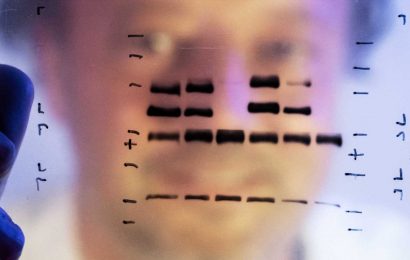Several common regions of DNA are linked to an increased risk of developing essential tremor (ET), new research shows.
Investigators studied more than 480,000 adults and found five genetic loci that were significantly associated with ET risk, particularly in the cerebellum and neuronal axons. Loci are physical locations of a gene or DNA polymorphism.
Results also showed a genetic overlap of roughly 30% with Parkinson’s disease (PD), suggesting that some genetic loci increase the risk for both ET and PD.
“Identifying these genetic loci is the starting point for understanding the biology of ET and will point to potential genes and molecular pathways, which may lead to novel and more targeted therapies,” lead author Calwing Liao, PhD, Department of Neurology and Neurosurgery at McGill University, Montreal, Quebec, Canada, told Medscape Medical News.
The findings were published online January 4 in JAMA Neurology.
Largest Study to Date
ET affects 1% of the general population and up to 5% of adults over age 65 years. It is “clinically characterized as a bilateral, largely symmetric kinetic or postural tremor,” the investigators write. ET “can greatly decrease quality of life and debilitate daily function.”
Previous studies have pointed to the cerebellum as particularly implicated in ET, but the genetic etiology of the condition “remains elusive, despite twin studies that have shown the trait to be hereditable,” the researchers note.
Past genome-wide association studies have identified “putative ET loci,” but these loci were not statistically significant at a genome-wide level, they add.
“In the literature, we haven’t seen consistent results on genetic findings for ET,” Liao said. “We wanted to conduct the currently largest ET genetic study to identify high confidence regions of DNA that increase the risk of ET, which informs on the disease biology.”
The investigators conducted a case-control genome-wide meta-analysis identifying significant loci for ET. They collected samples from multiple centers across Europe from January 2010 to September 2019. Cohorts were combined through an inverse-variance meta-analysis technique.
The researchers compared 7177 individuals with ET (51.45% women; mean age, 62.66 years) to 475,877 individuals who acted as the control group (53.33% women; mean age, 56.40 years). They further divided this population on the basis of study cohort, chip, and time of genotyping.
The investigators retained variants with an effective sample size of more than 70% of the full meta-analysis (n = 6,892,661 markers).
Common Genetic Predisposition
Results showed the heritability that could be explained by single-nucleotide variants (SNVs) was an estimated .1829 (SE, .0141), with a low level of confounding.
Genetic correlation, which “captures the degree of genetic overlap with another cohort or trait,” was calculated between cohorts, and the correlations were found to be “significant and positive, providing evidence that effects were consistent across cohort designs,” the researchers write.
They identified five independent genome-wide significant loci, which were associated with about 18% of ET heritability (P < 5 × 10−8). None of these top loci were found to be significantly heterogeneous, the investigators note.
“Functional analyses found significant enrichment in the cerebellar hemisphere, cerebellum, and axonogenesis pathways,” they write.
Fine-mapping of transcriptome-wide association study identified genes predicted to have altered their expression as a result of ET-associated common variants, in particular, BACE2, LRRN2, DHRS13, and LINC00323 in “disease-relevant brain regions, such as the cerebellum.”
The researchers also found that heritability was enriched in histone markers such as H3K9ac and H3K27ac, suggesting, “future studies could investigate the importance of epigenetics for ET.”
Importantly, ET was had a “significant genome-wide genetic correlation” with other diseases and straits ― notably PD and depression (ρg, .28; P = 6.44 × 10−8 and pg, .12; P = 9.78 × 10−4).
Moreover, 500 causally shared SNVs between PD and ET were identified, encompassing a total of 700 variants that influence ET and 4800 that influence PD.
“There is an underlying common genetic predisposition for ET, even across internationally multicenter cohorts,” Liao said. “Deeper clinical phenotyping will help identify more biology and lead to potential targeted treatments.”
Hypothesis Confirmed?
Commenting for Medscape Medical News, Holly Shill, MD, chair, Parkinson’s Disease and Movement Disorders, Barrow Institute, Phoenix, Arizona, said clinicians “have recognized for some time” that ET is often hereditary, particularly in patients with a younger onset of disease.
However, previous studies of large families with what appears to be a dominant inheritance pattern have “failed to yield putative genes,” which suggests that ET may be polygenic, even in those with apparent dominant inheritance, she noted.
This is like what is found in bipolar illness and cerebral aneurysms, “and it is exciting that the current study confirms this hypothesis,” said Shill, who is also from the Department of Neurology, University of Arizona College of Medicine, Phoenix, and is the medical advisory board chair of the International Essential Tremor Foundation. She was not involved with the current research.
“There are variants that are increased in both ET and PD. And, while we know that ET is not a risk factor for the development of PD and ET patients do not have increased PD pathology, it seems quite plausible that there may be common genetic mechanisms for tremor generation in these two disorders,” Shill said.
However, she cautioned that the study was only performed in individuals of European descent, “so it is not clear yet whether this will translate across other racial and ethnic groups.”
Nevertheless, the research does “pave the way for additional studies to determine whether some of the pathways underserved by the variants identified are abnormal in the brains of people with ET,” Shill said.
The study was funded by the Canadian Institutes of Health Research (CIHR). Liao reports receiving grants from CIHR during the conduct of the study. The other authors’ disclosures are listed in the original paper. Shill reports no relevant financial relationships.
JAMA Neurol. Published online January 4, 2022. Full text
For more Medscape Neurology news, join us on Facebook and Twitter.
Source: Read Full Article


